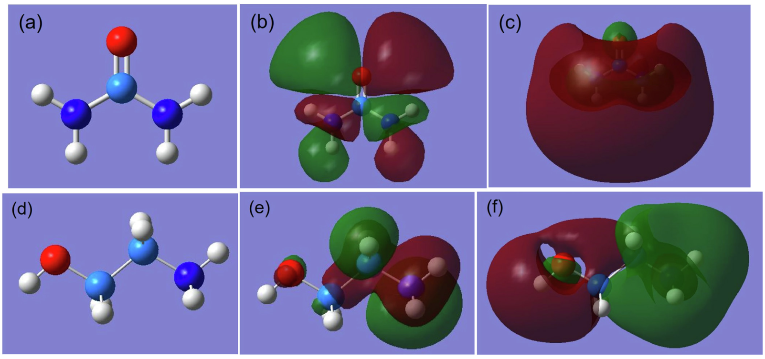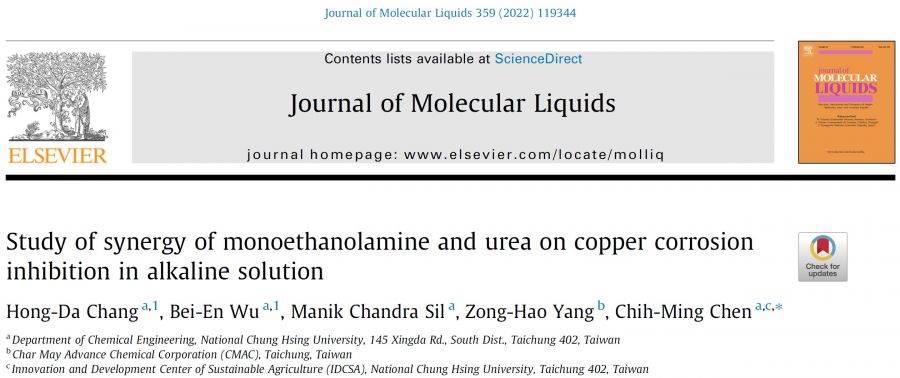設施農業:節能栽培與滅菌【化學工程學系/陳志銘特聘教授】
| 論文篇名 | 英文:Study of synergy of monoethanolamine and urea on copper corrosion inhibition in alkaline solution 中文:乙醇胺與尿素協同抑製鹼性溶液中銅腐蝕之研究 |
| 期刊名稱 | JOURNAL OF MOLECULAR LIQUIDS |
| 發表年份,卷數,起迄頁數 | 2022, 359, 119344 |
| 作者 | Chang, Hong-Da; Wu, Bei-En; Sil, Manik Chandra; Yang, Zong-Hao; Chen, Chih-Ming(陳志銘)* |
| DOI | 10.1016/j.molliq.2022.119344 |
| 中文摘要 | 四甲基氫氧化銨(TMAH)是化學機械平坦化和光刻後清洗工藝中使用的重要成分,然而,它的腐蝕性能對銅金屬化造成損害。在清洗液中加入腐蝕抑制劑是一種很有效保護銅的方法。在本研究中,使用乙醇胺 (MEA) 和尿素兩種腐蝕抑制劑研究對於銅腐蝕保護的協同作用,採用電化學和四點探針法分析銅的腐蝕行為,使用掃描電子顯微鏡、透射電子顯微鏡和原子力顯微鏡進行銅的微觀結構表徵分析,X射線光電子能譜分析抑製劑在銅表面的吸附行為。腐蝕電流與電荷轉移電抗的分析結果表明,由於兩種抑製劑的相互干擾,添加相同濃度的 MEA 和尿素不會對銅腐蝕保護產生典型的協同作用。MEA 濃度的增加克服了相互干擾,導致腐蝕電流降低和電荷轉移電抗增加,有效延緩銅腐蝕的原因在於足夠的抑制劑可以在銅表面形成緻密的保護層。 |
| 英文摘要 | Tetramethylammonium hydroxide (TMAH) is an important constituent used in the post cleaning process of chemical mechanical planarization and lithography; however, its corrosive property causes damage to the Cu metallization. Addition of corrosion inhibitor in the cleaning solution is a promising method to protect Cu. In this study, two corrosion inhibitors, monoethanolamine (MEA) and urea, are used to investigate their synergy on the Cu corrosion protection. Electrochemical and four-point probe methods are adopted to analyze the corrosion behaviors of Cu. Microstructural characterizations of Cu are performed using scanning electron microscopy, transmission electron microscopy, and atomic force microscopy. X-ray photoelectron spectroscopy is used to realize the adsorption behaviors of inhibitors on the Cu surface. The results of corrosion current (Icorr) and charge transfer resistance (Rct) indicate that addition of MEA and urea at an identical concentration does not produce a typical synergistic effect on the Cu corrosion protection due to mutual interference of two inhibitors. An increase of the MEA concentration overcomes the mutual interference, giving rise to a reduction of Icorr and an increase of Rct. The effective retardation of the Cu corrosion is attributed to the sufficiency of inhibitors which can construct a dense protection layer on the Cu surface. |
| 發表成果與本中心研究主題相關性 | 了解腐蝕抑制劑的相互干擾作用,透過配方調整可解決干擾問題並提升協同抑制效果。 |








